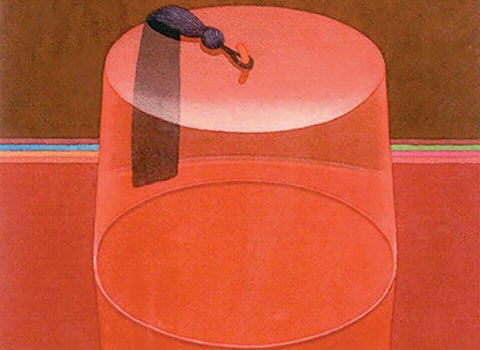Discussed in this essay:
Females: A Concern, by Andrea Long Chu. Verso. 112 pages. $12.95.
The Enigma of Clarence Thomas, by Corey Robin. Metropolitan Books. 320 pages. $30.
The Factory, by Hiroko Oyamada. Translated by David Boyd. New Directions. 128 pages. $13.95.

Mining I, by Nicole Eisenman © The artist. Courtesy Anton Kern Gallery, New York City
There are no men in the densely civilized galaxy of Samuel R. Delany’s 1984 novel Stars in My Pocket Like Grains of Sand. Everybody—whether human or extraterrestrial, and on all but a few backwater planets—goes by female pronouns, constituting a universal womankind. The word “he” no longer corresponds to any fixed identity, but applies to whoever makes the speaker aroused.
In Females: A Concern (Verso, $12.95), Andrea Long Chu argues that “everyone is female—and everyone hates it.” Female, as her slim and “wildly tendentious” polemic redefines it, is “a universal sex defined by self-negation”: “To be female is to let someone else do your desiring for you, at your own expense.” Women may be its “select delegates,” but identity-warping compliance with the sexuality of others is the human condition. Genders are but so many ways of coping with our vulnerability to others’ irresistible needs, and negotiating with the fact that “at bottom, everyone is a sissy.”
Chu’s witty and audacious essays on gender transition, television, and feminism’s sex wars—as well as her gleeful pantsing of Jill Soloway and Bret Easton Ellis in merciless reviews—have earned her a devoted following, and established her among the most original thinkers on questions of gender and sexuality. Especially concerned with the fraught role of desire in transfeminine identity, her position is best understood in contrast with two others: the widely accepted idea that trans women are simply born in the “wrong” body for their gender, wanting to be a woman having nothing to do with it; and the TERF, or “trans-exclusionary radical feminist,” view that trans women are in thrall to disempowering female stereotypes.
Though trans herself, Chu takes the TERFs’ position seriously—but reverses its implications. It may be that trans women “want” to be women, but this is hardly distinctive. Rather all women find that femaleness is a condition that can be neither fulfilled nor escaped. In this book, her first, Chu further radicalizes the argument. “Autogynephilia,” or the often ambivalent love of oneself as a woman, isn’t a trans aberration but a universal experience. “The entire Supreme Court is female,” she writes. “I am female. And you, dear reader, you are female, even—especially—if you are not a woman. Welcome. Sorry.”
As with any such sweeping provocation, what fascinates is where it leads. Striking the tone of a very online Enlightenment aphorist, Chu is less interested in exhaustive explanation than in the flash of insight produced by a well-thrown knife. Scouring culture for the female condition’s most unlikely expressions, she constellates such subjects as Freud’s castration complex; misogynist objectification among lesbians; trans beauty icon Gigi Gorgeous; The Matrix’s surprising sway over both trans people and incel men; and the story of a woman who not only ate but also “butt-chugged” several pages of Infinite Jest. This last was a theatrical rebuke to the countless men who bullied her to read it and, for Chu, a quintessentially female combination of resistance with self-abasement.
Men are yet more quintessentially female. In a particularly incisive section, Chu analyzes the incel subculture “nofap,” which encourages men aspiring to get laid to stop jacking off. Here, in the hard online heart of toxic masculinity, she identifies a deep-seated fear of being feminized, or turned into a “beta,” by watching porn. This is related to a desire, often verging on masochism, to be tested by attractive women and shaped by their expectations. Some incels, like trans people who seek gender confirmation surgery, even undergo bone-structure modification to enhance their masculinity and become “Chads.”
The implication is that men are equally susceptible to self-directed misogyny—which is to say that they are female, even if they have a strange way of showing it. (No-fappers bizarrely mirror antiporn feminists in their concern that porn is disempowering.) There’s even a kink that exemplifies this contradiction—“sissy porn,” a genre of hypnotic recordings wherein dominant female voices brainwash listeners into accepting a female identity. Chu describes it as “meta-pornography,” which “takes the implicitly feminizing effect of all pornography . . . and promotes it to the level of explicit content—often with spectacular results.” She would be in a position to know; near the end of the book, she speculates that perhaps “sissy porn did make me trans.”
It’s hard to imagine a constituency that Chu’s argument won’t trigger. She implies that trans women are deviants, that feminist women are in futile rebellion against “femininity,” that men are maximally repressed sissies, and that none of these things should necessarily be “fixed.” She even posits that politics is essentially “anti-female,” driven as it is by the desire for emancipation from others’ desires.
But Chu is likely expecting outrage. Her lodestar is Valerie Solanas, a radical lesbian writer known for shooting Andy Warhol and advocating in her SCUM Manifesto for the elimination of men. Chu, as she tells us in one of several autobiographical asides, was once named Andy, and the book’s sly conceit is that her gender transition and polemic are creative fulfillments of Solanas’s mission—as she wrote in an essay for n+1, “The Society for Cutting Up Men is a rather fabulous name for a transsexual book club.”
Counterintuitively, Chu’s confrontational approach is more embracing than a bland tolerance that “validates” everyone by retreating to subjective experience. Rather than invoke difference, she tells us that trans people should not have to prove that they are healthy when cis people are so manifestly unwell—at least by the criteria we use to pathologize the gender nonconforming. Readers should welcome her maximalist candor; as Friedrich Nietzsche, another talented aphorist, once wrote, “In affability there is no hatred of men, but precisely on that account a great deal too much contempt of men.” Of course, since there are no men, she might have appended Chu’s own disclaimer: “Maybe I’m just projecting.”

Guns, by Andy Warhol. Private Collection © 2019 The Andy Warhol Foundation for the Visual Arts, Inc./Artists Rights Society (ARS), New York City/Christie’s Images/Bridgeman Images
For contrarianism gone awry, there’s Corey Robin’s The Enigma of Clarence Thomas (Metropolitan Books, $30), an ideological portrait of the longest-serving and possibly most hated current member of America’s Supreme Court. Poised to leave a “broad and deep” legacy through his extreme-right opinions and influential former clerks, Thomas is among the most powerful conservatives in the United States. Yet apart from two notorious exceptions—his silence during oral arguments and his sexual harassment of Anita Hill—he is largely unfamiliar to the American public. His admirers consider him an orthodox “color-blind” conservative; his detractors, a full-on race traitor. Amiri Baraka called him “Tom Ass Clarence,” while Paul Beatty lampooned him as “Chamaeleo africanus tokenus,” a postracial reptile with “slimy feet gripped tightly around the judicial branch” as he gnaws “the leaves of injustice.”
Robin disputes this picture. Setting out to “make the invisible justice visible,” he argues that Thomas, an erstwhile campus “race man” who still admires Malcolm X, is an unreconstructed black nationalist for whom race and the interests of the black community remain paramount. His midlife conversion from radical to reactionary was not an abandonment of race consciousness, but rather a profound loss of faith in state-sponsored antiracist reform—and his trajectory is a cautionary tale for race pessimists on the left.
Few writers take their adversaries more seriously than Robin, a political theorist best known for The Reactionary Mind. Published in 2011, and expanded in 2018, the book is an intellectual history of the modern right as essentially counterrevolutionary, a political jujitsu that resists egalitarian reform. From Edmund Burke to Donald Trump, its mission has been to “make privilege popular” by encouraging ordinary people to identify with the losses of elites. Rejecting the low-energy ancien régime, whether Bush or Bourbon, conservatives posit a “natural” aristocracy forged in free-market competition, revanchist wars, and other sublime arenas of conflict.
What appeal could reaction hold for a black man born in Jim Crow Georgia? Judiciously braiding intellectual and biographical analysis, Robin tells the story of a man shaped by his tiny black hometown of Pin Point; the stern patriarchal grandfather who raised him; and an experience of integration at Holy Cross and Yale Law School that left him feeling stigmatized as an affirmative-action ornament. Radicalism briefly attracted him—he participated in left-wing demonstrations and cofounded his college’s Black Student Union—but when the revolution failed to materialize, he moved on to corporate law before his fast-track ascension through government. Conservatism was compatible with his distrust of civil rights, his preference for honest racism over the liberal alternative, and a lifelong conviction that there is “nothing you can do to get past black skin.”
“The country has seen black conservatives,” Robin writes, but “it has never seen a conservative black nationalist on the Supreme Court.” Thomas may fit in an intellectual lineage from Booker T. Washington to Thomas Sowell, but he is the first to reconcile his views with an “unaccommodating and anachronistic vision” of the Constitution. The bizarre result is a kind of originalist Afropessimism—to borrow a label often applied to black intellectuals who see racism as America’s unbudgeable cornerstone. Most such thinkers still embrace collective struggle, but Thomas sees the nation’s racial power structure as a brute fact to accept.
“The goal of Thomas’s conservative black nationalist jurisprudence,” writes Robin, is “to persuade black people to give up their illusion that politics can positively affect their condition and perhaps to abandon politics altogether.” He opposes using judicial power to end race-based gerrymandering because he believes that numerical minorities should expect to lose, and that voting rights safeguarded by courts are provisional white patronage. He wants to end affirmative action because he believes the stigma it imposes on black students is worse than any exclusion. He wants to rehabilitate the punitive power of states because cops and prisons ostensibly make black neighborhoods safe.
Where Thomas does want to empower black people—through gun rights, which protected black freedmen from lynching, and in the marketplace, which elevated his entrepreneurial grandfather—it’s as private actors waging an ennobling struggle against adversity, as though the private sphere were less racist than our at least nominally egalitarian politics. Staunch advocate of a black America that lives only in his imagination, he has scornfully abandoned the one that really exists. Yet he has said, “It pains me deeply, more deeply than any of you can imagine, to be perceived by so many members of my race as doing them harm.”
Why listen to Clarence Thomas? Because he sounds a lot like “us.” Robin’s closing argument is that the enigmatic justice shares many foundational assumptions with the increasingly race-conscious and pessimistic left, namely, that “racism is permanent, the state is ineffective, and politics is feeble”—a vision that Thomas has done his share to realize. Wondering if the “anti-racist ideal”can survive belief in racism’s permanence, Robin holds out the once-radical Thomas as a warning to race-first thinkers and activists losing faith in multiracial democracy. The contentious implication (which I wish he had explored at greater length) is that a short distance lies between believing that white supremacy is ineradicable and making bitter accommodations with it. What is the armed, insular, carcerally disciplined black capitalist America that Thomas envisions but a kind of soured safe space?

“HDR_nature 022,” by Yoshinori Mizutani, from the HDR_nature series © The artist. Courtesy IBASHO Gallery, Antwerp, Belgium
Safety hangs like a miasma over Hiroko Oyamada’s The Factory (New Directions, $13.95), a surreal workplace novella by the winner of Japan’s 2013 Akutagawa Prize. Translated by David Boyd, Oyamada’s first work to appear in English is narrated by three new hires at an eerie corporate campus that is slowly enveloping the surrounding world. Boasting residential districts, karaoke bars, a museum, a “factory anthem,” and nearly a hundred cafeterias, its exact purpose is unclear—as is its need for infantilized employees who, anxious to please and never knowing quite what is expected of them, gradually surrender their autonomy.
Oyamada, herself a former temp, envisions three young people demoted to the labor twilight zone by job insecurity. A liberal-arts graduate is assigned to destroy documents on the “Shredder Squad,” while her brother, a fired systems engineer, proofreads obscure technical manuals and a mental-health guide emblazoned with smiling anthropomorphic dumplings. The strangest job belongs to a discouraged graduate student hired to “green-roof” the factory with moss, an impossible task about which his employers care little but which occupies him for the next fifteen years.
Japan was once renowned for the mutual loyalty of its companies and salarymen, who could plausibly aspire to lifetime employment at a single firm. But Oyamada’s characters are haunted by more twenty-first-century problems, like the advent of “flexible” part-time labor and the unnervingly intimate dependence fostered by multinationals as large and ubiquitous as states. In a wry, deadpan style, she distills the profound unease of a world where companies grow more and more imperceptibly controlling even as they promise workers less.
Very little happens in The Factory, and Oyamada’s tendency to plot through the drifting accumulation of odd encounters—strolls, moss hunts, co-worker dinners, the vanishing or sudden appearance of colleagues—would have been more effective in a longer work. The characters, possibly by design, are regrettably indistinct. But the narcotized vision of an endlessly accommodating company town feels prescient in the era of “smart cities” chartered by Alphabet, Amazon, or Mohammed bin Salman; in plans for Neom, a futuristic city-state, the Saudi crown prince has promised an artificial moon composed entirely of drones.
Strange beings haunt the margins of such simulacral utopias. In The Factory, employees are cautioned to avoid a nearby woods because of the “Forest Pantser,” an elderly man, possibly on the company’s payroll, who attempts to tear the trousers off anyone he encounters. The wildlife goes similarly haywire. Detergent-eating lizards take up residence behind the washing machines, laying eggs in foam and nesting in lint, while a swarm of Hitchcockian birds occupies the south side of the factory. Could a corporate campus really cause such strange transformations, like The Island of Doctor Moreau? “The factory is a big place,” a supervisor warns. “Bigger than you know.”









































































































